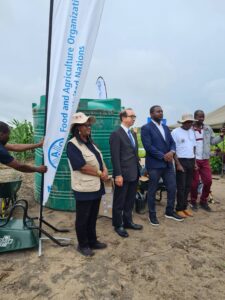
By: Annakleta Haikera
The Japanese government on last week Thursday has handed over agro-input and gardening tools worth about N$3,9 million (US$226,000) to the Diworoka community garden at Marema village in the Kavango West.
Speaking on behalf of the Japanese ambassador to Namibia Hisao Nishimaki , the Assistant Food and Agriculture Organisation (FAO) representative Ferdinard Mwapopi said the donation was done in line with Japan’s overarching goals and strategic anchors as part of the Sustainable Development Goals (SDGs) and as part of their emergency response and resilience-building to improve livelihoods, food security and nutrition in locust-affected regions in Namibia.
“The Food Agriculture Organisation strategic framework for 2022-31 seeks to support the 2030 Agenda through the transformation to more efficient, inclusive, resilient and sustainable agri-food systems for better production, better nutrition, a better environment, and a better life, leaving no one behind. The four betters represent an organising principle for how FAO intends to contribute directly to sustainable development goals for no poverty, and zero hunger and SDG 10 of reduced inequalities as well as to support the achievement of the broader SDG agenda, which is crucial for attaining food agriculture organisation’s overall vision,” Mwapopi said.
He also added that the four betters reflect the interconnected economic, social and environmental dimensions of agri-food systems.
“They also encourage a strategic and systems-oriented approach within all FAO’s interventions. It is in line with this global perspective and the responsibility to ensure that our efforts are indeed geared towards contributing to ‘leaving no one behind’, hence our being here at Diworoka community garden, and by extension other targeted beneficiary communities to address the needs of the most vulnerable groups. And, it is our conviction that through these joint efforts, Kavango West region and Namibia at large, would hopefully attain SDGs 1, 2 and 10 while beneficiaries will be the testimonies of a diversified, resilient and market-driven livelihood system,” he said.
According to the Kavango West governor Sirrka Ausiku, the region is still young since it was only created in 2013.
“The region is highly rural and the key statistics that we keep monitoring are the poverty rate stands at 27.9%. Regional unemployment rate at 33%, and youth unemployment at 46.6%. The Namibia Multidimensional Poverty Index Report from the National Security Agency of 2021 found that the incidences of multidimensional poverty were the highest in Kavango West region at 79.6%,” Ausiku explained.
She said the statistics are worrisome to those that are in the region, especially in agriculture, manufacturing and tourism sectors and that they believe with good investments the region can create needed employment and address poverty.
“This time around the embassy is supporting our smallholder horticulture farmers. The materials we are receiving from you, will assist the smallholder horticulture farmers to produce more and thus improve food security at the household level and the livelihoods of their communities. I am also happy that the majority of the beneficiaries are women and our youth. They are really responding to the 2021-2022 SORA theme ‘Kavango West Going Green’,” she pointed out.
According to the Namibia Statistics Agency, Kavango West’s literacy rate for those 15 and older stands at 77% and their main source of income is farming, at 60%. In 2011 the region was rated severely poor.









Comments